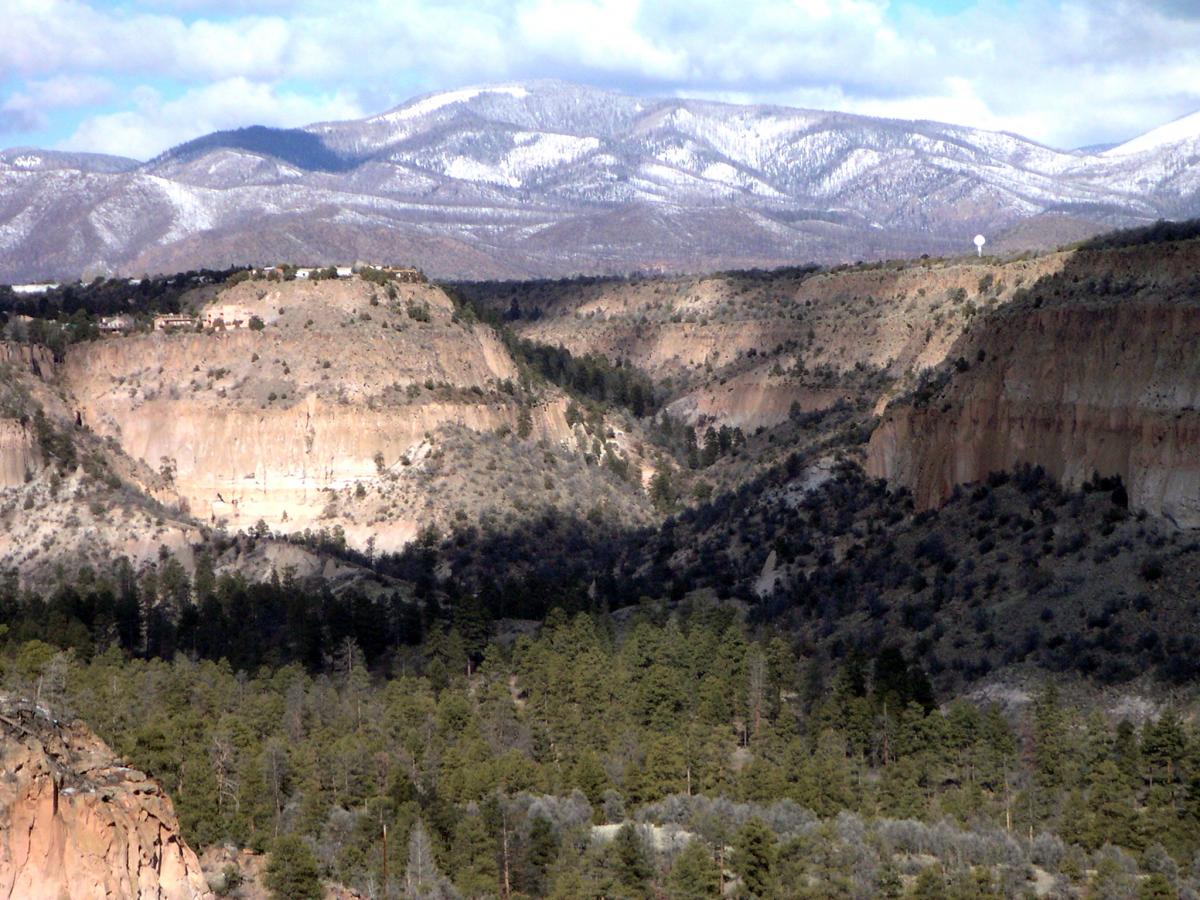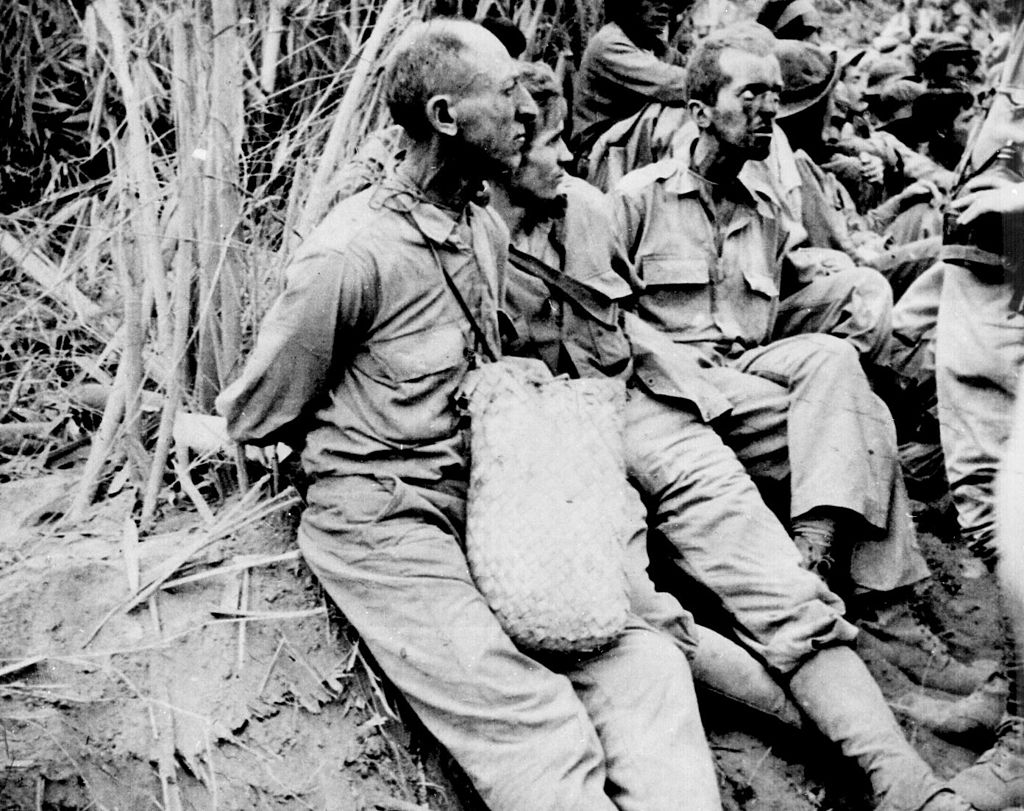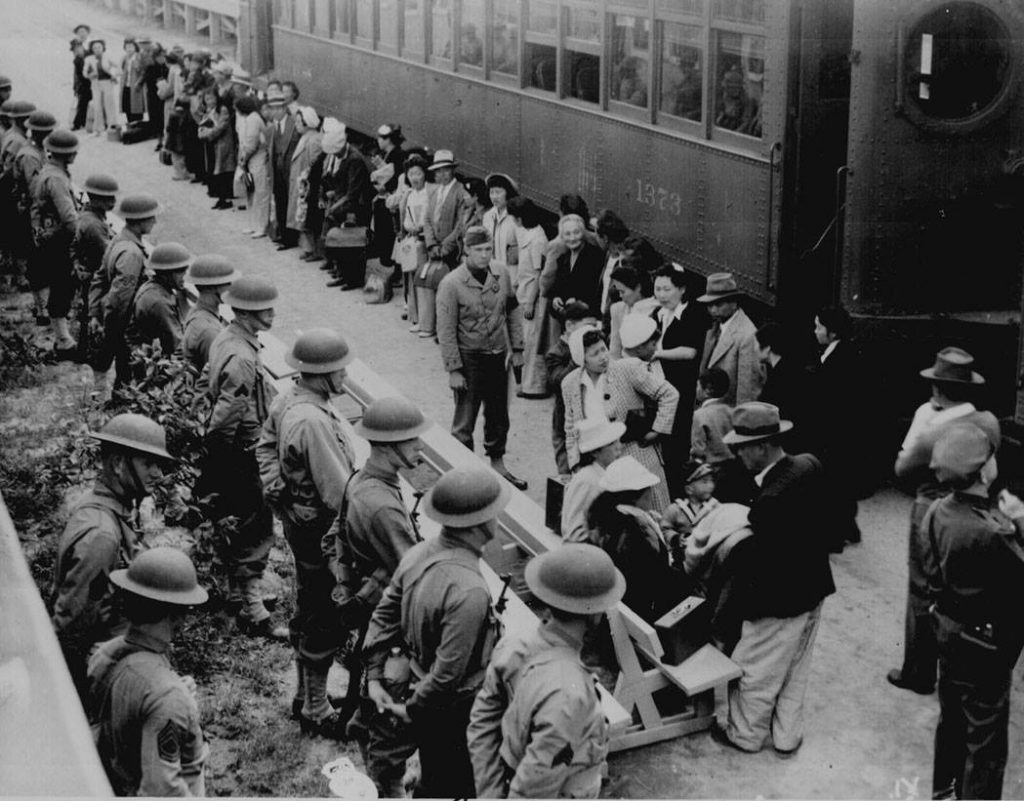World War II became a formative period in the history of New Mexico. Besides the Manhattan Project, which continues to influence the state to this day, World War II had unique advantages and consequences for other aspects of New Mexico and its residents.
The Manhattan Project
The success of the Manhattan Project ensured that the military, large-scale government science, and the state of New Mexico would be tied together for decades to come. After World War II, the federal government took control of millions of acres of New Mexico land, which it used to build military bases, missile ranges, and R&D facilities. The laboratory at Los Alamos became part of a new network of National Laboratories around the country.
The Sandia National Laboratories became the second National Laboratory in New Mexico. Also focused on nuclear weaponry, Sandia was built in Albuquerque near the Kirtland Air Force base. Millions of federal dollars and jobs flowed into New Mexico. As the University of New Mexico grew in size and prestige, its science and engineering departments began to work closely with the National Laboratories in New Mexico.
New Mexico’s natural resources also helped promote the state’s nuclear industries. In the 1950s, a Navajo shepherd named Paddy Martinez discovered a large hunk of uranium near Grants, NM. This touched off a massive mining rush; by the 1980s, 40% of America’s uranium supply was mined and milled in what became known as the Grants Uranium Belt. For more on the history of uranium mining and its consequences, visit the Environmental Protection Agency’s website.
Today, New Mexico has more scientific and technical workers per capita than any other state in the union. Electronics firms relocate to New Mexico to be near Los Alamos and Sandia, and to take advantage of the pools of expertise they draw on. Federal investment and the National Laboratories have made New Mexico a center of science and technology.
Native Americans on the Pueblos

Native Americans consitute a major portion of New Mexico’s multi-ethnic make up. During the Manhattan Project, with Puebloans, Hispanos, Europeans, and people from throughout the United States in residence, the town of Los Alamos saw a diverse mixture of traditional and modern, and the cooperation of all the people who worked there was vital to its success.
The arrival of the Manhattan Project in Los Alamos in 1943 was, at the time, believed to be a temporary “interference” by outsiders into northern New Mexico. Instead, the “lab on the Hill” has since become a permanent reality of the Pajarito Plateau. On an international scale, the laboratory at Site Y ushered in the nuclear age; on a local scale, it brought many changes to Pueblo communities that claimed the Pajarito Plateau as their ancestral land. Some of these changes meant new commercial opportunities and employment for some of the northern Pueblos; others set in motion a legacy that is still controversial today. Close interaction with members of the Pueblos also enriched the lives of many Los Alamosans, Americans and foreigners alike, who had never before encountered Native American cultures.
Given its close proximity to the secret city, it was mainly the San Ildefonso Pueblo that provided most of the laborers Los Alamos needed on any given day, although daily laborers were also recruited from other nearby Pueblos, including Santa Clara, Cochiti and San Juan. Every day of the week, workers traveled by bus to the Hill, where they received their assignments and returned home at sunset. Men were generally employed as truck drivers, construction and maintenance workers, carpenters, and gardeners. Women were recruited as maids and child-care providers. Their skills were vital for the entire Los Alamos community. Many workers labored in silence given their very limited English and the complete unfamiliarity with local languages on the part of Los Alamos residents.
As time went by, many of the Hill’s residents developed an almost romantic appreciation of the customs and traditions of their Pueblo neighbors. Local crafts like rugs and pottery became hot-selling items, and the demand for them was often higher than the available supplies could provide. In order to keep up with their backorders, some local artists learned to sacrifice their intricate paintwork for simpler art themes. They began to mass produce their wares for sale, undoing centuries-long traditions of making items one at a time for special occasions. Local economies shifted from the centuries-old subsistence or bartering system to a cash economy, which some scholars have called a “plutonium economy.”
Local economies shifted from the centuries-old subsistence or bartering system to a cash economy, which some scholars have called a “plutonium economy.”
The Pueblo economy became increasingly dependent on the outside world. Where in the past it took days to complete clay multicolored jars, it now took just a few hours to produce bi-color vases. The secret city’s residents also began to venture outside the fences to attend occasional Pueblo feast days, during which they were invited to eat in Pueblo homes and watch celebratory dances.
Overall, the encounter between Pueblo nations and the Los Alamos community seems to have produced a mixed legacy, especially for the Pueblos. The greatest impact was felt by the San Ildefonso Pueblo, which was geographically the closest to the Laboratory. For instance, as more and men and women from the Pueblos were recruited for daily work at Site Y, villages were depopulated for most of the day and traditional activities, including childrearing for women and agricultural work for men, could no longer be performed.
The 43 square miles on the Pajarito Plateau occupied by the Los Alamos community incorporated also some of the San Ildefonso ancestral land. With time, contaminants from the Hill were detected in water and air samples taken on or near Pueblo lands. The Pueblos were provided annual funds to evaluate the extent and possible health and environmental effects and to participate in decisions concerning cleanup levels.
Despite these issues, local leaders also recognize the transformation of Pueblo life brought on by the Manhattan Project and their cultural assimilation into New Mexican life and the economy. An important dimension of the project’s legacy on the northern Pueblo communities is to reconcile the economic benefits of integration and the preservation of ancestral identities and ways of life.
Contributions to the War Effort Overseas
The Battle for Bataan
New Mexicans were among the first to fight in the Pacific War. In August 1941, the 200th and 515th Coast Artillery regiments of the New Mexican National Guard were given notice that they had been selected for an overseas assignment and were deployed to the Philippines. They initially trained at Fort Stotsenburg, but were drawn into combat after Japan attacked Pearl Harbor on December 7. The Japanese invasion of Luzon began on December 10. After several months of fighting, the Bataan Peninsula fell on April 9, 1942, when 12,000 American and 58,000 Filipino soldiers surrendered.
The Japanese rounded up the captured men into long columns and instructed them to march. For the next seven days, the men were forced to walk 75 miles in more than 100-degree heat, were given no food or water, and had little rest. The Japanese soldiers who accompanied the march tortured and murdered freely, and over five thousand would die. Some guard used bayonets to prolong death, pushed bodies in front of tank paths, or even forced prisoners to stand to attention in the midday sun until some dropped of heat exhaustion. Following the end of the march, the prisoners were packed into hot steel boxcars with barely enough room to breathe. During this 45-mile ride, men continued to die from heat and exhaustion. Upon arrival, they marched ten more miles when they arrived at Camp O’Donnell, a former Filipino training base. “You are guests of the Emperor,” a Japanese official greeted them in English. “We will work you to death.”
The prison camps in the Philippines were not the end for the dwindling number of survivors of the death march and other POWs. In May, the Japanese began transferring POWs to meet labor shortages in Japan, China, and Korea. Packed into “hell ships,” the prisoners barely had enough room to stand or breathe. A small canteen and bucket of rice would be occasionally lowered into the cramped hold, and these rations would be auctioned off every time a man died. The ships were not marked as prison ships, and thus were susceptible to enemy fire. Five ships were sunk by the American navy, and about 10,000 POWs lost their lives at sea as a result.
Of the 1,800 New Mexican men sent to the Philippines, 900 survived the Battle for Bataan, the horrors and atrocities of the “death march,” and the privation and deep humiliation of the 40 months spent in POW camps. For more information on the Bataan Death March, click here.
Navajo Codetalkers

During the first few decades of the 20th century, the United States government began a policy of forced assimilation for many Native American tribes, including the Navajos of Arizona and New Mexico. A particularly focus was placed on eliminating the Navajo language, as the Bureau of Indian Affairs established boarding schools where teachers forbade the speaking of Navajo. The Navajo language would nevertheless go on play a crucial role in the United States’ victory in the Pacific during World War II.
With the war underway, the United States military was searching for an “unbreakable” code similar to the Enigma machines used by Germany. This would allow the military to transmit messages to the front lines by radio, even if the enemy could intercept communications. Philip Johnston, the son of a missionary to the Navajos and a fluent speaker of the language, convinced the Marine Corps that Navajo (which at the time was estimated to be spoken by less than 30 non-natives) could be the solution. The Navajo language is virtually undecipherable to anyone not already familiar with it. It is unwritten, has no alphabet, and relies on complex tones and variations.
In May 1942, the first 29 Navajo code talkers were recruited and sent to a training camp. They had to develop a dictionary of military terms, which started at approximately 200 words and grew to over 400 by the end of the war, as well as an encrypted alphabet that could spell English words. They thus used a code system within a language that almost no one could speak by sending a string of seemingly unrelated words. To see the code talkers’ dictionary, click here.
Over 400 code talkers were deployed during the war, serving in every Marine unit in the Pacific. The code was so effective that a captured Navajo soldier from the U.S. Army in the Philippines later commented, “I never figured out what you guys who got me into all that trouble were saying.” During the Battle of Iwo Jima, six code talkers sent over 800 messages without a single mistake. Major Howard Connor later asserted, “Were it not for the Navajos, the Marines would never have taken Iwo Jima.” The Japanese never broke the Navajo code.
The secret of the code talkers was not declassified until 1968 because of the military value they still held. In 1982 President Reagan awarded a Certificate of Recognition to the code talkers and declared August 14 to be National Navajo Code Talkers Day. In 2001, President Bush awarded the Congressional Gold Medal to the original 29 code talkers, most posthumously.
Japanese in New Mexico
In 1942, President Roosevelt signed Executive Order 9066, which authorized the declaration of the western United States as a “military zone.” Largely the result of war hysteria brought on after the bombing of Pearl Harbor, this led to the internment of over 120,000 nikkei, or those with Japanese ancestry. Despite accusations, there has never been any evidence of espionage activities by Japanese-Americans during this time.
With internment underway, the Wartime Civil Control Administration ordered Japanese-Americans to report, bringing only what they could fit in a suitcase. The War Relocation Authority began the construction of internment camps, including one at Santa Fe at a former Civilian Conservation Corps camp. The Santa Fe camp interned 4,555 Japanese-Americans between 1942 and 1946. Its prisoners received better treatment than at other internment sites, as it was administered by the Department of Justice.
There were two other internment sites in New Mexico: Lordsburg and Fort Stanton. These were administrated by the army and were run more like prison camps. The Lordsburg camp even held German and Italian POWs at the same time. Those deemed particularly dangerous were sent to these camps, primarily male issei, or first generation Japanese-Americans born in Japan. In March 1945, a riot occurred at the Santa Fe camp when inmates protested the transfer of some prisoners to Fort Stanton, and tear gas was used. The Santa Fe camp remained open beyond the end of the war, until the spring of 1946.
In recent years the National Park Service has awarded a series of grants to preserve the history of the Japanese internment camps. In 2002, a stone monument and plaque were dedicated at Frank S. Ortiz Park in Santa Fe, the site of the former internment camp. For more on the Japanese-American relocation and internment camps during World War II, click here.








